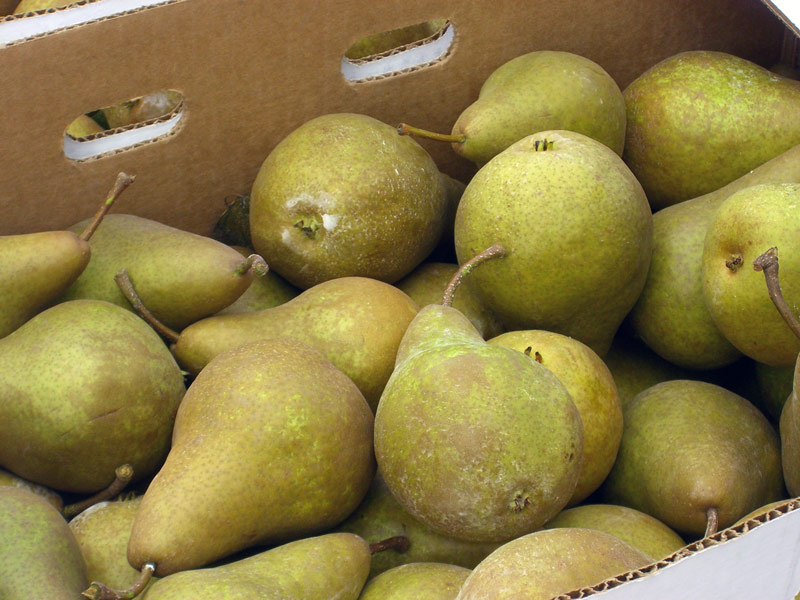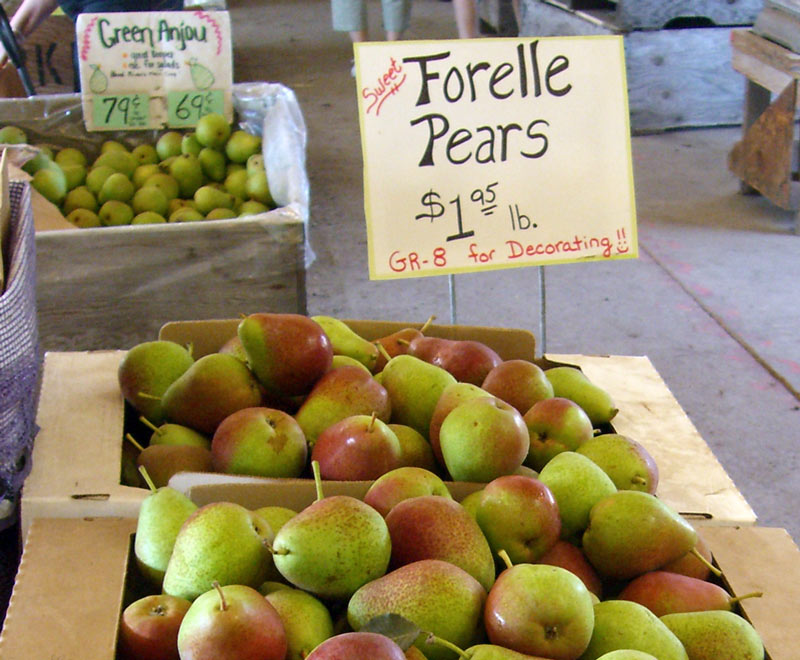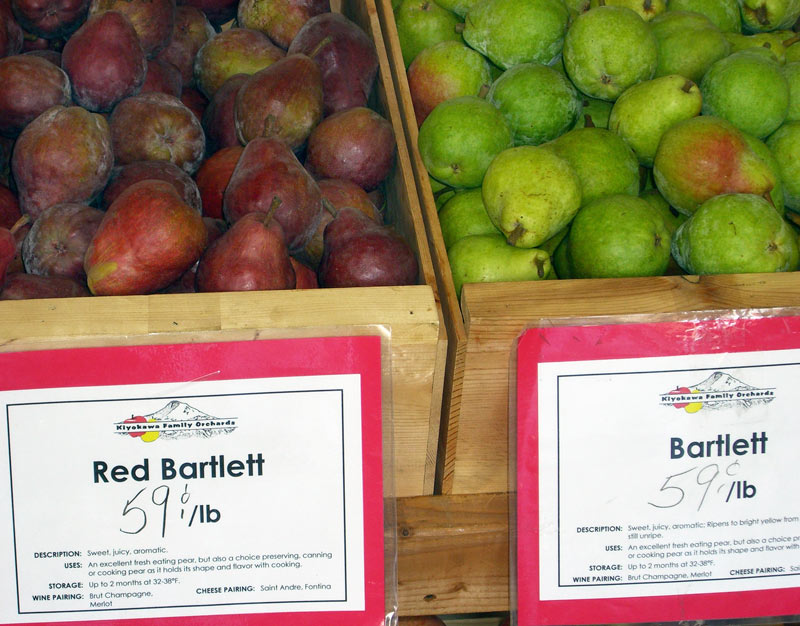By the time the glory of fall comes to a close in the Northwest and heavy rains, wind, and fog settle in for their seasonal run, there are only two regional fruits left for the cook—apples and pears. Apples are coming to the market from controlled atmosphere storage and can be variable in quality—but pears, picked long before they actually ripen, are usually in good form and have the decided advantage of not turning immediately to mush as apples do when subjected to room temperature.

Only two types of pears are grown in the northwest: summer pears, ripening during the first half of August, and winter pears, ripening toward the end of August and into September. Bartlett pears, both golden and crimson, fall into the first category. Everything else, Anjou, Bosc, Comice, Winter Nelis, Forelle, and Seckle, lands in the second category.

Although California leads the nation in Bartlett pear production, only a small portion of that amount is sold to the fresh market; leaving Washington and Oregon the incumbent task of supplying the nation with out-of-hand Bartletts, which they do admirably to the tune of 84% of all fresh pears grown in the United States and more than 94% of all winter pears. Together, Washington and Oregon also account for 92% of America’s fresh pear exports.

An oddity in the fruit world, pears benefit from harvesting prior to maturation. Both flavor and texture are improved by the brief to lengthy storage period off the branch. In the case of Bartletts, early picking combined with off-the-branch ripening is sufficient to rid the fruit of its inherent mealiness. With winter pears, a longer storage time is essential for full flavor and texture development.
Today growers use two methods: simple cold storage which slows the ripening process sufficiently to allow the beneficial characteristics to emerge, and controlled atmosphere storage (CA) which virtually stops the aging process altogether. CA is a process whereby the oxygen levels in the sealed cold storage vaults are substantially reduced, thus surrounding the pears with the carbon dioxide they themselves produce. Together, cold storage and controlled atmosphere storage make it possible to enjoy fresh pears well into early spring, securing their position as the most important regional winter fruit.

Season
Pears are divided into two categories: Summer pears, such as Bartlett and Red Bartlett and Winter pears, such as Comice, Anjou, Bosc, Seckle, Nelis, and Forelle.
Selection
Summer pears lighten in color as they ripen providing a reliable visual aid for determining edibility. Winter pears, on the other hand, seldom change color at all. To tell if these are ripe, press with your thumb at the stem end; if the flesh yields to gentle pressure, the pear is ready to eat.
A few of the more commonly available types include:
Bartlett
The Bartlett is a graceful, bell-shaped summer pear that ripens in late July and continues to be available throughout December. Bartletts turn from green to yellow (sometimes with a crimson blush) as they ripen. This is due to chlorophyll disappearance during the ripening process. The flesh is white, smooth, and juicy, with excellent flavor. Bartletts are prized as canning pears and are excellent all-purpose pears; good for eating fresh and for cooking.
Red Bartlett
The Red Bartlett, a summer pear, has the same general characteristics as the regular Bartlett pear, although it is a gorgeous dark red that turns to crimson as it ripens. The supply is somewhat limited; generally available from August to October only.
Anjou
A winter pear, available from October through May, the Anjou or D’Anjou as it is often called, may be light green or yellow-green, and still be in any stage of maturity from hard to ripe and ready to eat. This pear is almost egg-shaped with little neck or shoulder definition; it has a short stem. It is thin-skinned, with smooth-textured white flesh. When ripe, its flavor is sweet and spicy and its flesh is very juicy. The Anjou is the most abundant of all fresh pear varieties and is excellent for eating fresh and for cooking.
Bosc
This winter pear, available from September through May, is easy to recognize with its long tapering neck and slim stem. A ripe Bosc has golden brown skin with a network of russeting over golden yellow. The flesh is tender, buttery, and aromatic. The Bosc is and excellent pear for baking, broiling, and poaching; also great for eating out-of-hand. It’s best peeled, as the skin tends to be tough.
Comice
A winter pear, available from October through March, the Comice will sometimes turn from green to greenish-yellow and exhibit a crimson blush on its cheek as it ripens, although the pressure test is a more reliable method for determining ripeness. The Comice has a chubby shape with a short, defined neck, and a short stem. Eating quality is superb. These pears are very sweet and juicy. It’s best for eating out-of-hand, as they disintegrate too easily with cooking.
Nelis
The Winter Nelis is available from October through April. It is a medium to small pear with light brown russeting over a light green skin that becomes more golden when ripe. Its shape is fairly rounded with almost no neck definition. The flesh is creamy and sweet, with good cooking and canning qualities.
Forelle
The Forelle is a small winter pear, available from October through February. It is somewhat larger than the Seckle. Its shape is more elongated, often with a fairly definite shoulder, and an overall bell-like appearance. It is a very attractive, highly colored pear. As it ripens, the Forelle turns a golden yellow with brilliant red contrasting blush and pronounced “freckles” on its tender skin. The flesh is sweet and juicy.
Seckel
A winter pear, available from August to January, the Seckel is the smallest of all pear varieties. Often bite-size, it can be green with a substantial dark red blush, or nearly all red. In the ripening process the red becomes brighter and the green takes on a yellow hue. The flesh is a warm light ivory. Excellent for eating fresh, this pear is also fine for cooking.
Storage
Pears are one of the few fruits that do not mature well if allowed to ripen on the tree. Therefore, they are always picked in an unripened state and carefully packed, stored, and shipped in that condition. They will usually ripen perfectly if allowed to sit at room temperature for 3-5 days. Conversely, once a pear has ripened, it must be refrigerated to maintain its quality; ripe pears will hold in the refrigerator for about 5 days.
Preparation
If the skin of a pear is thin and smooth, such as that of a Bartlett, it may be left on. The skin of many of the winter pears is too coarse to be edible, however. Simply remove it with a vegetable peeler.
Pears darken (although not as quickly or extensively as apples) when their flesh is exposed to air. Brush cut surfaces with lemon juice to prevent discoloration.
Pears are left whole with the stem on for many preparations. Just as frequently, they are cut into quarters lengthwise, the core sliced from each section with a small paring knife, and the stem removed.
Cooking
When they are to be cooked, all pears, regardless of type, should be slightly under ripe. The heating process will soften the texture sufficiently. Pears that are thoroughly ripe to begin with may well disintegrate during cooking. Jane Grigson, in her fine cookbook, Jane Grigson’s Fruit Book, is of the opinion that cooked pears, because of their delicate flavor, always need help from another fruit, if only fresh lemon juice or zest. I agree with this, except when the pears are caramelized, which in itself adds a great deal of flavor. Pears should not be overwhelmed with too assertive a secondary ingredient if you want the delicate pear flavor to come through. I am of the opinion that chocolate and pears should never meet on the same plate for instance. Not because the combination is unpleasant but because you just cannot taste the nuances of the pear when chocolate is present. So much for the classic dessert, Poires Héléne.
One of the most dramatic ways to alter and add dimension to the basic flavor of the pear is to poach it in either simple syrup flavored with spices or in sweetened white or red wine. Heightened in this way, pears can stand up to more assertive accompaniments and flavorings.
Great Partners
Almond, almond paste, allspice, anise, apple, apricot, Applejack, apricot, Armagnac, bacon, blue cheese, brandy, brown sugar, butter, Calvados, Cambozola, Camembert, caramel, cardamom, cider, cinnamon, cognac, cloves, cranberry, crème fraiche, cream, cream cheese, currants, eggs (custard), fennel, ginger, ginger root, Gorgonzola, hazelnut, Grand Marnier, greens (especially peppery) honey, lemon, lettuce, lime, maple syrup, Marsala, mascarpone, mint, nutmeg, orange, Parmesan, peach, pecans, pepper, pork, praline, prune, raisins, raspberry, Roquefort, rosemary, rum, sour cream, squash, strawberry, Stilton, toffee, vanilla, vinegar, walnut, watercress, wine, yogurt.
Additional Pairings
LunaCafe Recipes
- Caramelized Pear Salad with Gorgonzola, Candied Spiced Walnuts & Spicy Orange Vinaigrette
- Caramelized Pear and Anise Tart (PNP)
- Pear and Ginger Tart (PNP)
- Poached Pears and Sabayon with Toasted Walnuts (PNP)
- Boned, stuffed Duck with Prunes and Seckle Pears (PNP)
- Butterflied Roast Quail with Gingered Pear and cranberry Sauce (PNP)
- Noisettes of Pork with Pears and Crème Fraiche (PNP)
NOTE PNP = Pacific Northwest Palate: Four Seasons of Great Cooking
Resources
- Pear Bureau Northwest
- Pear Varieties
- Northwest Pear Fact Sheet
- Pear Panache
- Pears USA
![]()

